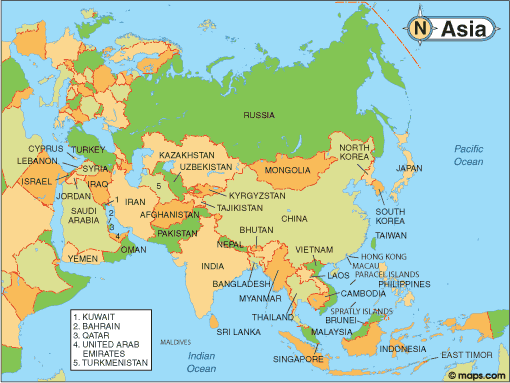|
 Asia is the world’s largest continent as well as the most populous, home to 3/5 of the world population. In the map to the right you can see how small the European continent appears in comparison to Asia. (Although some schools of thought would consider Europe and Asia to be one continent, but we won’t go into that discussion here). Asia is the world’s largest continent as well as the most populous, home to 3/5 of the world population. In the map to the right you can see how small the European continent appears in comparison to Asia. (Although some schools of thought would consider Europe and Asia to be one continent, but we won’t go into that discussion here).
The geography of Asia is varied and extreme, including:
- the northern lowlands covering west central Asia and most of Siberia,
- the vast central highland zone of high plateaus with some rising to about 15,000 feet [4750 meters],
- the world’s greatest mountain ranges (Himalayas, Karakorum, Kunlun, Tian Shan and Hindu Kush)
- the southern peninsular plateaus of India and Arabia,
- the lowlands of eastern Asia, separated by mountain ranges
The highest peak in the world, Mt. Everest (29,035 feet [8856 meters]) as well as the lowest point, the Dead Sea (1312 feet [400 meters] below sea level) are located on the Asian continent.
Six identifiable regions exist on the Asian continent, each possessing distinctive physical, cultural, economic, and political characteristics.
- Southwest Asia (including the Middle East, Asia Minor and Arabia), long a strategic crossroad, is characterized by an arid climate and irrigated agriculture, great petroleum reserves, and the predominance of Islam.
- South Asia (Afghanistan, Pakistan, India, Nepal, Bhutan) is isolated from the rest of Asia by great mountain barriers.
- Southeast Asia (Thailand, Burma, VietNam, Cambodia, Laos and the Malay Archipelago) is characterized by a wet, rainy climate, a focus on maritime operations, the blending of Indian and Chinese cultures, and a great diversity of ethnic groups, languages, religions, and politics.
- East Asia (China, Mongolia, Korea, and the islands of Taiwan and Japan) is located in the mid-latitudes on the Pacific Ocean, and is characterized by cultures strongly influenced by civilizations of the Huang He and Chang (Yangtze) river systems. This region of Asia is the most industrialized at this time.
- Russian Asia (comprises the northern third of the continent) consists of the vast region of Siberia and the Russian Far East, probably the least populated area of Asia.
- In the center is Central Asia, formed of a set of independent former republics of the Soviet Union. The region is characterized by arid conditions necessitating irrigated agriculture, and is influenced by ancient traditions of nomadic herding.
Although we count not get an exact count, it appears that there are about 30 distinct languages (not including dialects) spoken by the people of the Asian continent. Is that Universal Translator developed yet?
At the time we are writing this, we are not sure how many of these countries we be be able to visit on the motorbike. Some countries we are currently not able to visit for political reasons. Others, while we could visit using public transportation, do not make it easy to bring in a private vehicle for personal transport purposes. We would obviously like to visit them all, but that may not be possible or feasible.
We start our adventures in Turkey (in 2005), the closest country on the Asian continent to Europe (it is actually on both continents). It may be a while before we are able to visit many more of the exciting destinations on this continent.
|

 Asia is the world’s largest continent as well as the most populous, home to 3/5 of the world population. In the map to the right you can see how small the European continent appears in comparison to Asia. (Although some schools of thought would consider Europe and Asia to be one continent, but we won’t go into that discussion here).
Asia is the world’s largest continent as well as the most populous, home to 3/5 of the world population. In the map to the right you can see how small the European continent appears in comparison to Asia. (Although some schools of thought would consider Europe and Asia to be one continent, but we won’t go into that discussion here).